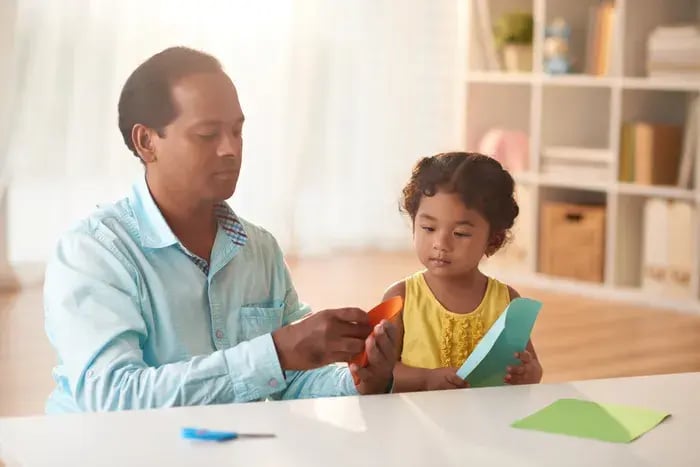- Watercolor Resist Art
- Paper Collage Creations
- Group hand print murals
- Cotton Swab Pointillism
- DIY Paper Plate Masks
- Nature-Inspired Leaf Printing
- Recycled Material Sculptures
- Develops Creativity and Expression of Self through Art
- Develops fine motor skills
- Teaches collaboration and socializing
- Develops Cognitive and Problem-Solving Skills
- Fun Alternative to Screens
Introduction
It is a very exciting time for a child to learn creativity by using hands-on activities in kindergarten. In fact, doing craft is one of the best ways of engaging a group of children to work together, share, and express themselves. Learning activity books for kids provide structured learning but crafts introduce an element of free expression that fosters imagination and social skills. In any classroom, daycare, or home, group craft activities promote teamwork and enhance fine motor skills. Whether painting or collage-making, folding paper or stamping, these activities are both fun and educational. When looking for some creative ways to keep a group of kindergarteners entertained, here are some easy craft activities to try:
7 Easy Craft Projects For Kindergarten: How To Create Projects For Group Engagements
Watercolor Resist Art
Draw shapes and patterns with crayons on the sheet and paint over them in watercolors. The wax resists the paint, revealing bright and colorful designs that pop out of the sheet. This is a great way to teach kids about the mixing of color and improve their motor control. Watercolor resist art can be used for theme-based projects like animals, landscapes, or festivals.
Paper Collage Creations

Paper collages stimulate children to create different designs by working together. A giant group collage or individual pieces can be made using paper cut-outs, fabric pieces, and colored paper. They improve fine motor skills, patience, and ability to identify patterns and textures.
Group hand print murals
Handprint murals are a fun activity in which children can contribute to a collective piece of art. Using non-toxic paint, each child will place his hand on the large paper. Once dried, one can transform handprints into animals, flowers, or an abstract pattern. This creates a sense of belonging and teamwork.
Cotton Swab Pointillism
Let the kids understand pointillism by creating art using dot patterns with the help of cotton swabs dipped in paint. Let the children collectively work on a group project to create a gigantic rainbow or garden scene. It teaches them to be patient and focused, thus making them realize how minute components come together to form an overall image.
DIY Paper Plate Masks
Paper plate masks allow kids to use their creativity to design animal faces, superheroes, or festival-themed masks. Providing glue, paper cutouts, and colors helps them personalize their masks. This group activity encourages role-play, storytelling, and teamwork as kids interact using their creations.
Nature-Inspired Leaf Printing

Take the kids outside to gather leaves of different shapes and sizes. Using paint, they can stamp the leaves onto paper and create beautiful prints. This is an activity that encourages appreciation for nature while at the same time enhancing sensory skills. Groups can compare their designs and discuss the different patterns that emerge.
Recycled Material Sculptures
Cardboard boxes, bottle caps, and newspaper material sculptures; group children can work on sculpting using those items. Theme it with ideas such as 'robots' or 'animals', this activity gives sustainability, solving, and team-working skills-a great way of instilling the culture of awareness through craft.
5 Benefits of Craft Activities For Kindergarten Kids
Develops Creativity and Expression of Self through Art
Craft allows children to indulge in colors, textures, and materials without fear. Through doing group projects, they develop a personal artistic voice while learning appreciation for others' ideas and their creativity.
Develops fine motor skills
Cutting, pasting, and painting help develop the eye-hand coordination in the child and strengthen the finger muscles. These are essential skills, as they prepare children to write, draw, and perform all other fine movements involved in performing at school.
Teaches collaboration and socializing
Group crafts teach the children how to share materials with one another, express their ideas, and collaborate to deliver a common objective. This forms cooperation, patience, and a sense of community.
Develops Cognitive and Problem-Solving Skills
Crafting demands decisions, sequences, and the trial of new materials. It helps in enhancing cognitive flexibility and logical thinking abilities while solving the creative challenges that may arise.
Fun Alternative to Screens

While learning through activity books is wonderful, hands-on crafts are screen-free and help children stay busy. Crafting also improves focus and minimizes fidgeting.
Tarishi Shrivastava is a young writer who has covered a range of topics on children's health, including nutrition, fitness, sleep, and parent-child bonding. With a keen interest in simplifying wellness for parents, she brings a practical and engaging approach to her writing. Beyond work, she enjoys exploring new ideas, staying curious, and creating meaningful content.
The views expressed are that of the expert alone.
The information provided in this content is for informational purposes only and should not be considered a substitute for professional medical advice, diagnosis, or treatment. Always seek the advice of your physician or another qualified healthcare provider before making any significant changes to your diet, exercise, or medication routines.
References
https://www.redtedart.com/origami-for-preschool/
https://www.thesprucecrafts.com/crafts-for-kindergarteners-1254247










